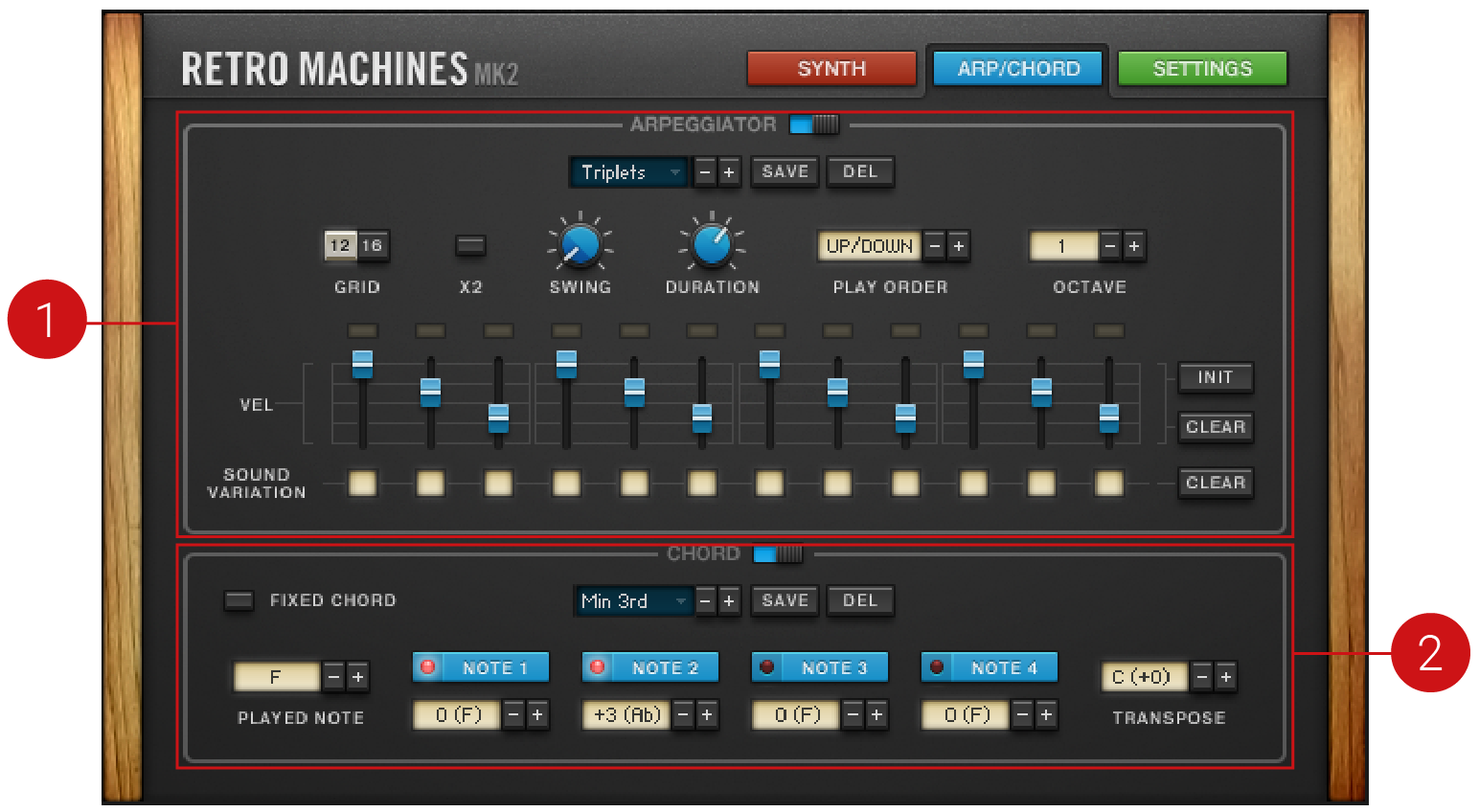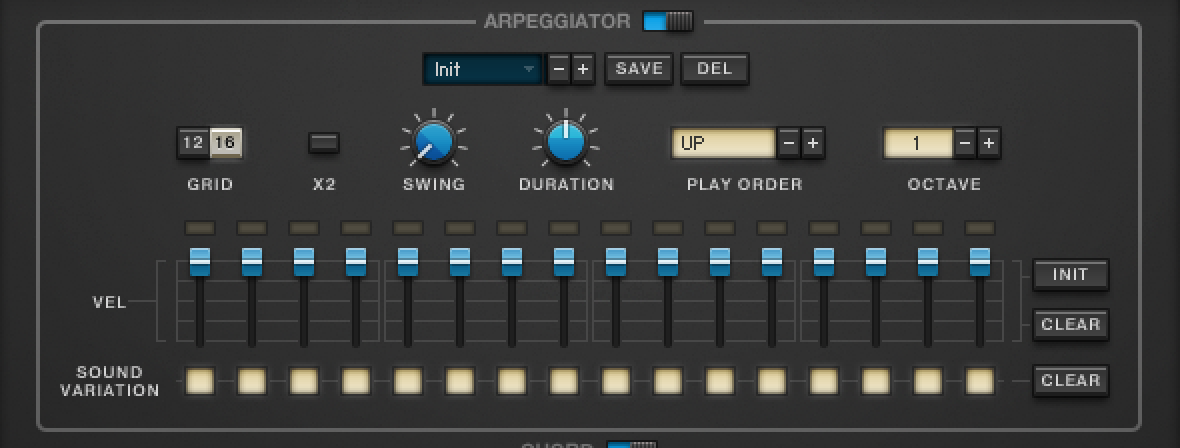Arpeggiator and Chord Page
Use the Arpeggiator and Chord Player in RETRO MACHINES MK2 to quickly create dynamic arpeggios and sophisticated chords.
RETRO MACHINES MK2 contains an Arpeggiator and Chord Player for quickly creating dynamic arpeggios and sophisticated chords.
To open the Arpeggiator and Chord page, click the blue ARP/CHORD button.
 |
ARPEGGIATOR: Includes a 16 step arpeggiator based on vintage sequencers. Here you can adjust the arpeggiator settings to change the play order, swing, and octave range. To create more dynamic sounds, alter the velocity and set a variation for each step, so the preset constantly evolves and changes over time. For more information refer to Arpeggiator.
CHORD: Contains the Chord Player for creating chords from single notes. Here you can use preset chords from the menu or create your own by adding the interval for each note. For more information refer to Chord.
Arpeggiator
An arpeggiator automatically steps through a sequence of notes based on an input chord, thus creating an arpeggio. The arpeggiator in RETRO MACHINES MK2 is inspired by the arpeggiators found in the original machines. Choose 16 steps or 12-step triplet mode, and define the velocity of each step. You can also assign a different sound variation to each step in the pattern for dynamic, expressive arpeggios. Arpeggiator settings can also be saved as presets and recalled at any time.
If used in a DAW (digital audio workstation), the arpeggiator will be synced to the tempo and the position in the host application; for example, if the transport starts at beat 3, the arpeggiator will start from step 9.
The arpeggiator contains the following parameters and controls:
 |
ARPEGGIATOR (on/off switch): Activates/deactivates the Arpeggiator.
Preset menu: Selects an arpeggiator preset (click the arrow to open the drop-down menu). You can also click on the name of a preset to type in a new preset name.
Next (+ icon): Selects the next arpeggiator preset.
Previous (- icon): Selects the previous arpeggiator preset.
SAVE: Saves changes made to the current arpeggiator preset. If it was a factory preset, a copy is created in the user area. If it was a user preset and no name changes have been made, the preset will be overwritten.
DEL: Deletes the current arpeggiator preset.
GRID: Selects 12-step triplet mode or 16-step mode.
X2 (double-time): Doubles the tempo from 16th to 32nd notes or 12th to 16th triplets.
SWING: Offsets the second and fourth steps in 16th mode to create a swing feel. Swing only works in GRID 16-step mode.
DURATION: Sets the duration of the arpeggiated notes. At maximum, consecutive notes will overlap (useful when SOLO and LEGATO in the Perform section are activated).
PLAY ORDER: Defines the note order for the arpeggiated pattern.
OCTAVE: Sets the octave displacement, for instance, the distribution of the arpeggio pattern in various octaves. The arpeggio pattern cycles from the played octave to the octave set upwards.
VEL: Set the velocity of the individual steps with the velocity sliders. Cmd-click a slider to set it to zero, [Alt] click it to set it to maximum velocity.
INIT: Initializes the rhythmic grid and sets all sliders to the maximum. [Alt]-click this button to randomize all active sliders (all sliders greater than zero).
CLEAR (upper): Clears the rhythmic grid; for instance, sets all sliders to zero. [Alt] click this button to randomize all variations.
SOUND VARIATION: Selects a Sound Variation for the corresponding step here (click on a field and drag up/down to select one of the eight variations).
CLEAR (lower): Clears the Sound Variation grid. [Alt] click this button to randomize the variation steps for all active sliders (all sliders greater than zero).
Chord
RETRO MACHINES MK2 features an advanced approach to playing chords. The Chord Player creates chords from single notes, which is especially useful when combined with the Arpeggiator.
The Chord Player contains the following parameters and controls:
 |
CHORD (on/off switch): Activates/deactivates the Arpeggiator. The Chord feature cannot be used when SOLO is engaged on the Synth page.
FIXED CHORD: If enabled, each note of the chromatic scale will be harmonized with the same chord. Otherwise, each note of the chromatic scale can trigger a different chord.
Preset drop-down menu: Selects a chord preset. You can also click on the name of a preset to type in a new preset name.
+ (plus sign): Selects the next chord preset.
- (minus sign): Selects the previous chord preset.
SAVE: Click here to save any changes made to the current chord preset. If it was a factory preset, a copy will be created in the user area. If it was a user preset and no name changes have been made, the preset will be overwritten.
DEL: Click here to delete the current chord preset.
NOTE 1–4: Activates/deactivates the 1st to 4th chord notes.
NOTE 1–4 Interval: Sets the interval for the 1st to 4th chord note intervals.
PLAYED NOTE: Only visible when FIXED CHORD is off. This note shows the incoming MIDI note to be harmonized.
TRANSPOSE: Only visible when FIXED CHORD is off. You can transpose the chord set with this control.